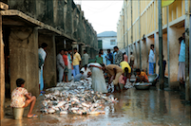By Elana Sulakshana
The front page of the New York Times on March 28th featured an article on the plight of Bangladesh—one of the countries most vulnerable to the rising temperatures and sea levels due to climate change. This is an example of the inequality of climate change; Bangladesh and other developing nations hardly contributed to the climate crisis, yet they are facing the greatest risks.
On the Notre Dame-Global Adaptation (ND-GAIN) index of climate vulnerability, which measures a nation’s exposure, sensitivity and ability to cope with climate related hazards, Bangladesh is ranked 147. The index closely resembles a ranking by GDP, with developed nations facing the least risks from natural disasters, increased temperature, rising sea level, and the other impacts of climate change. From 1993 to 2012, Bangladesh was the fifth nation most affected by extreme weather events, in terms of fatalities and economic losses, according to Germanwatch’s Global Climate Risk Index 2014.

Bangladesh is threatened by rising sea levels due to climate change.
The projections for the country are astounding—and terrifying. According to climate scientist Atiq Rahman, executive director of the Bangladesh Center for Advanced Studies, models predict that rising sea levels will flood 17% of Bangladesh by 2050, leading to the displacement of some 18 million people. Bangladesh is also uniquely vulnerable to natural disasters, such as cyclones, and is currently experiencing severe coastal erosion.
Bangladesh is posed to experience huge economic losses as people lose their land and livelihoods, though the nation accounts for just 0.3 percent of the greenhouse gas emissions causing climate change. Many small island nations are experiencing a similar situation, highly in danger of permanent inundation, despite tiny populations and a minimal carbon footprint. The Carteret Islanders of Papua New Guinea, for example, were forced to move at the beginning of April due to the threat of rising sea levels; the island is expected to be completely underwater by 2015. This makes them the first entire community to be displaced because of climate change.
Just seven countries account for 63% of the carbon emissions from the industrial age through 2005. The U.S. ranks number one, followed by China, Russia, Brazil, India, Germany and the U.K. With the exception of China and India, they are all developed nations. Additionally, many of the emissions of developing nations are due to western countries “outsourcing” their emissions to developing nations with the production of cheap goods. The prime example of this is China. Additionally, when emissions are calculated per capita, the developed countries’ numbers have overwhelmingly higher rates.
Because of this huge discrepancy, the developing nations are holding these 7 nations, and other developed ones, accountable. In recent talks, particularly COP19, the United Nations climate change negotiations in early November, small islands and other developing nations demanded both financial aid and other forms of assistance, such as refuge for migrants forced to flee for climate reasons, from the developed nations.
They spoke of a mechanism of “loss and damage,” a term coined by vulnerable island nations that refers to compensation for the “losses and irreversible damage, including non-economic losses” that have already arisen and will continue to arise due to the climate disruption, according to a statement from G77+China . These same nations staged a walkout at COP19, targeting the developed countries that have refused loss and damage and have consistently held back progress on climate action.
Though the negotiations led to the establishment of the “Warsaw Mechanism on Loss and Damage,” there is still a long way to go to solve these complex issues of inequality within climate change.
This is the first piece in an upcoming series on climate change and inequality.
Photo courtesy of Aftab Uzzman.
